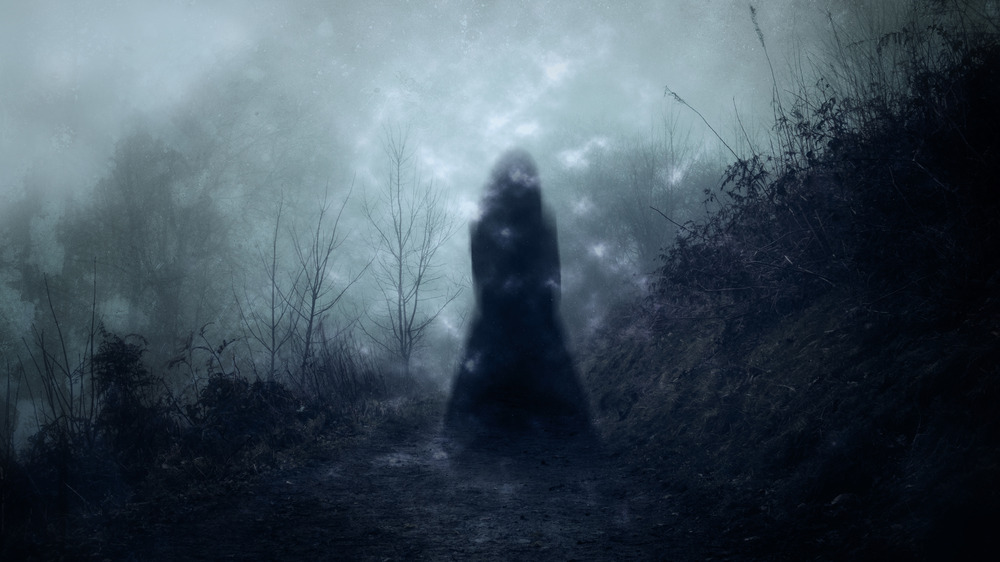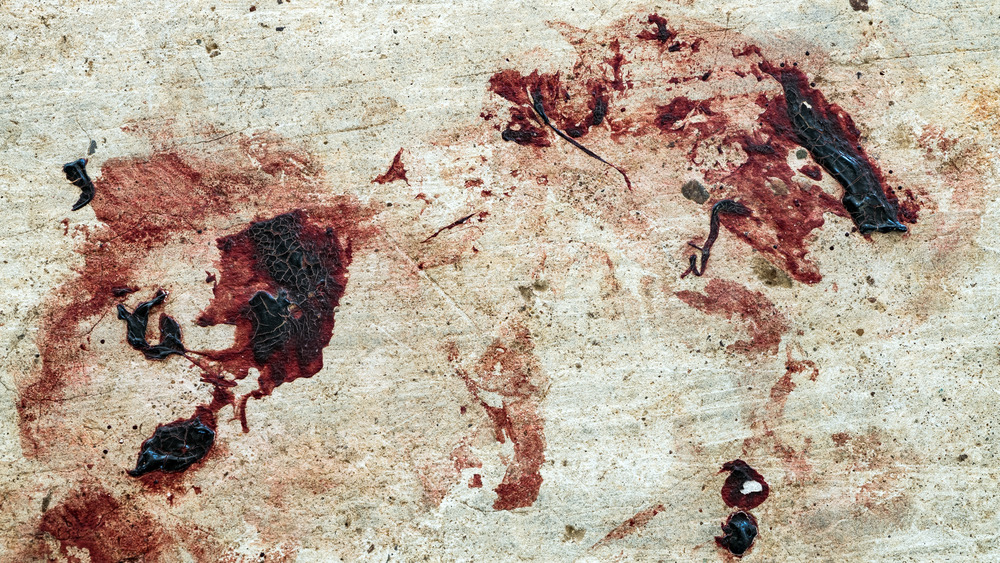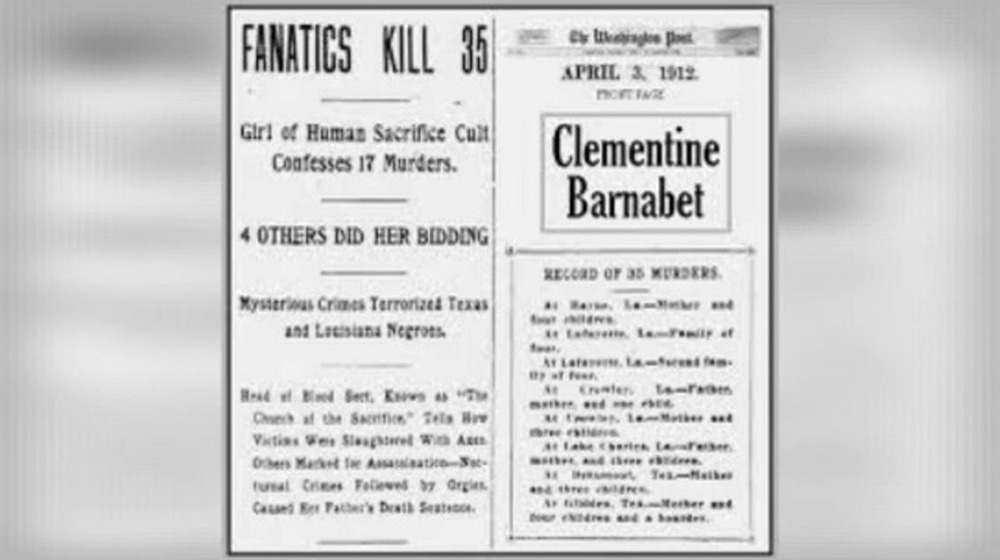What You Didn't Know About Serial Killer Clementine Barnabet
Clementine Barnabet is thought to be the first Black female serial killer in United States history. According to Serial Killing: A Podcast (posted on YouTube), Barnabet was born in 1894 in Saint Martinville, Louisiana to Nina Porter and Raymond Barnabet. Her father was reportedly a petty thief and sharecropper with a violent temper who was unfaithful to his wife and abusive to his entire family, which also included a son, Zepherin. They moved to Lafayette, Louisiana in 1909 and "lived in a rundown part of town."
The family also was rumored to be involved in a local cult known as The Church of Sacrifice, according to Serial Killing host Elissa Kerril — "an equal opportunity cult" with an equal number of male and female members. The group's supposed core belief was that it was possible to obtain riches and other possessions via human sacrifice. Clementine Barnabet was rumored to have become a leader within the cult at the age of 17.
A series of horrific ax murders
According to The Strange Case of Clementine Barnabet, a paper by Dr. Vance McLaughlin presented the 2012 Homicide Research Working Group Annual Symposium, between 1911 and 1912 "in towns along the Southern Pacific railroad line running through Louisiana and Texas, a minimum of 12 African-American families were murdered in their homes." As reported by Mental Floss, the first family identified as possibly connected to the case was that of a woman named Edna Opelousas and her three children, who were murdered in Rayne, Louisiana in 1909. McLaughlin notes that the first family identified as part of the murders in 1911 was that of Walter J. Byers, his wife, and their child, who lived in Crowley, Louisiana. It was determined that someone had come in through a window and killed the family as they slept, but no other clues were available.
Three weeks later and 30 miles away in Lafayette, a killer took the lives of Alexander, Mimi, Joachim, and Agnes Andrus. Once again the family was murdered in their sleep, but this time the murder weapon, an ax, was discovered on the floor. The Lafayette Advertiser ran a front page story about the murders, noting its similarity to the murders of the Opelousas and Byers families and wondering if the crimes, "so alike," were "the work of the same terrible monster." According to McLaughlin, Raymond Barnabet was arrested for the Andrus murders but released two days later due to lack of evidence.
Raymond Barnabet arrested for murder
As reported by Mental Floss, a month later, Alfred and Elizabeth Casaway were murdered along with their three children in a similar manner to the previous slain families. Authorities began once again suspecting and investigating Raymond Barnabet. According to the book Axes of Evil: The True Story of the Ax-Man Murders, Barnabet was arrested again, this time based on evidence from a woman with whom he was having an affair named Diana. Diana reportedly told a friend "some frightening things about the ax murders" that led the friend to believe Barnabet was the murderer. The friend passed this information on to the police, which led to Barnabet's arrest.
Both Raymond Barnabet and Diana denied the friend's story, frustrating the officers and leading them to question Raymond's by then estranged wife, Nina, and children, Clementine and Zepherin. All three "had no anxiety about implicating Raymond as the Ax-Man." During Raymond's trial in October of 1911, he didn't take the stand; per McLaughlin, he "sat dejectedly behind the defense table, muttering 'Goodbye' and 'Mo foutu' (I am gone) loud enough for the jury to hear."
Clementine testified against her father
When Clementine Barnabet took the stand to testify against her father, per McLaughlin, she swore "that he arrived home, the night of the Andrus murders, with his blue shirt covered in blood and brains. She said her father bragged that he killed a whole family that night and told Clementine to wash the blood out of his clothes, which she did." Zepherin backed up his sister's story. Nina denied seeing any bloody clothes but testified that Raymond had threatened to kill her a month before. Raymond was found guilty and sentenced to death by hanging.
As Raymond Barnabet sat in jail, however, another horrific murder took place in Lafayette, Louisiana on November 26, 1911. Norbert Randall was shot in the head and killed while his wife and three children were attacked and killed with an ax, according to Mental Floss. Lafayette Parish Sheriff Louis LaCoste had become suspicious of Clementine and Zepherin Barnabet due to their bad reputations and their neighbors describing them as "filthy, shifty, degenerate"; he arrested them both. Authorities searched the Barnabet home and found "a complete suit of woman's clothes in [Clementine's] room, saturated with blood and covered with human brains" as well as blood on the door latch. Zepherin had an alibi for the night of the Randall murders; Clementine did not, and she was taken to jail. As both Raymond and Clementine Barnabet sat behind bars, the ax murders continued.
Barnabet admitted to 35 murders
As reported by Mental Floss, in January of 1912, three more families were murdered. In the instance of Felix Broussard, his wife, and their three children, the killers left messages on the wall of the Broussard home, including one signed by "Human Five." This led to the media nickname "The Human Five Gang" as well as the ongoing story that the murders were connected to the practice of Voodoo. The El Paso Herald ran a front page story emblazoned with lurid pictures and the title "Voodoo's Horrors Break Out Again." The ongoing emphasis on Voodoo as well as the fact that "rumors were swirling that Clementine was the leader of some kind of cult called the 'Church of Sacrifice'" kept the already terrifying ax murders at the forefront of the news cycle as well as the general public's psyche.
On April 5, 1912, Clementine Barnabet made a "full confession, admitting to 17 murders." She also claimed "she had bought a Voodoo charm meant to protect her while committing her crimes" and that she and her accomplices "drew lots to see who would commit the murders." Her story was inconsistent and all over the place. Not only had she already implicated her father in the crimes, but when she named her accomplices, they were "nowhere to be found." Despite suspicions as to the verity of her story, authorities filed charges against Clementine on April 14, 1912. She went on to admit to a total of 35 murders.
Barnabet was released after 10 years in prison
Despite Clementine Barnabet "re-telling her story with differing details that make it hard to know the truth," per Mental Floss, and the unsubstantiated rumors about the probably non-existent Church of Sacrifice and Voodoo sacrifices, she stood trial. Her attorneys attempted to defend her by reason of insanity, but she was declared guilty and sentenced to life at the Louisiana Penitentiary. She was just 19 years old. Clementine unsuccessfully attempted to escape on July 31, 1913, but was otherwise considered a "model prisoner." According to a report from the prison, Barnabet "received a "procedure" that was said to have "restored" her to her "normal condition"" and she was released after serving 10 years. Little is known of her later life.
As noted by Dr. McLaughlin, the process used to "cure" Barnabet is unknown and "lobotomies were not performed until 10 years later in the United States." Furthermore, Clementine Barnabet "was the only person ever punished for any of the ax murders mentioned," making it unclear if she had any accomplices, particularly since many of the murders happened while both she and her father were behind bars. History professor Dr. Jeff Anderson told Mental Floss that either Clementine or "someone in her house performed the majority of the murders," but due to her constantly changing stories he doubted that "she totally committed all of the murders that she said she did."





